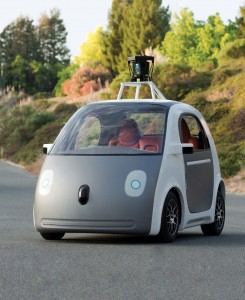
On May 28, at the Code Conference in Palos Verdes, California, Google co-founder Sergey Brin revealed a surprise. The tech world already knew that Google has been developing self-driving cars that use laser scanners, cameras, and radars to map nearby terrain, track cars and pedestrians, and even identify construction zones. The vehicles avoid swerving cyclists, stop at traffic lights, and move around Google’s Mountain View neighborhood as naturally as a human-driven SUV. The computer-controlled cars have already logged more than 700,000 autonomous miles. Until recently, they’ve also had a few features we’ve become accustomed to since the advent of the horseless carriage. Steering wheels, for instance. Gas pedals. Brakes.
Mr. Brin explained that Google has cast aside these accouterments. Onstage, his hosts showed off a video of a two-seat electric prototype with an emergency stop button, but no steering wheel or familiar pedals. Brin compared the experience of driving in one of the prototypes to sitting in a chairlift. And while he broke the news of this radical new prototype casually, punctuating his armchair presentation with the occasional chuckle, the unveiling took months of intense planning, according to Claire Hughes Johnson ’90, vice president of Google[x] Self-Driving Cars. “It’s a nuanced story,” she says. “One of the hardest things was that this was not a launch.”
At this point, Google isn’t selling a product. The company is selling an idea. So Claire and her colleagues wanted the story to center less on the physical prototype than on the broader technology developments and their implications. “It’s going to take some time for the technology to realize its potential,” she says. “So it took a series of steps to make sure people had an opportunity to think through all the angles.”
The self-driving car project is part of the Google[x] division — the so-called moonshot factory that pursues revolutionary concepts. In 2012, the group released a video of a self-driving Toyota Prius squiring a blind man around town. Since then, however, they have kept their advances quiet. Claire, a Google veteran who helped launch flagship products like Gmail, had been following the project internally, but it wasn’t until last year that Google[x] director Astro Teller and engineer Chris Urmson convinced her to join them. Her mandate is to bring the technology to market, but she can’t divulge how Google intends to do that. So, in the meantime, one of her roles is to act as an evangelist for the technology, showing regulators, politicians and the general public how self-driving cars could benefit the world.
 After joining the team, she noticed a disconnect between the national conversation around self-driving cars and what was happening inside Google[x]. In 2013, the National Highway Traffic Safety Administration (NHTSA) defined five different categories for these smart cars, from a level zero, which is controlled entirely by the driver, to an entirely autonomous level four. Most automakers appear to be progressing gradually away from zero, slowly introducing new and more intelligent features, such as adaptive cruise control.
After joining the team, she noticed a disconnect between the national conversation around self-driving cars and what was happening inside Google[x]. In 2013, the National Highway Traffic Safety Administration (NHTSA) defined five different categories for these smart cars, from a level zero, which is controlled entirely by the driver, to an entirely autonomous level four. Most automakers appear to be progressing gradually away from zero, slowly introducing new and more intelligent features, such as adaptive cruise control.
Google decided to go straight for the fully autonomous, no-human-in-the-loop automobile. The logic was simple: If, according to NHTSA, 93 percent of accidents are results of human error, why not get rid of the human and let the computer drive? Google’s cars can see out to 200 meters in all directions. They don’t have blind spots. They don’t text. The only accidents logged during those 700,000 miles were the result of other cars knocking into a Google-mobile at a traffic light.
Still, the idea of getting rid of the controls was ground-breaking, so Claire and her colleagues decided to let people know what they were doing. “We felt we should share, as early as we could, the concept that we’re going to skip to level four,” she says.
After months of planning, they began the reveal by re-stoking interest in the technology. On May 14, her team hosted a press day at Google. They invited members of the media to ride in earlier versions of the self-driving cars — a fleet of Lexus SUVs with updated software that allowed them to drive on surface streets, not just highways. Then they brought in a panel of academics to discuss how self-driving vehicles could change mass transportation, alleviate parking problems in cities, and more. At this point, the new, steering-wheel-free prototype was still a secret, but the media were given a glimpse of how far the technology had come. A few years ago, for example, the car would have recognized a cluster of pedestrians as an amorphous blob. Now its software can distinguish, and track, each individual person in a group.
Two weeks after the press day, Mr. Brin made his announcement, and Claire’s team also released four videos. One focused on the people who would benefit from self-driving cars, including the elderly and the disabled. The other three videos featured the engineers developing the technology. The first video soon went viral, but Claire wasn’t sitting at her desk, tracking view counts. For all the potential reach of a video or a well-placed news piece, she makes an effort to tell the story of the self-driving car in person. Sometimes, this involves meeting with state regulators, city officials, and other business leaders on Google’s campus, and arranging for brief rides in the car so they can experience the technology firsthand.
The day of the announcement, though, she was in Washington, D.C., discussing some of the potential uses for the vehicle with an unnamed White House official. Claire, who worked briefly in politics after graduation from Milton, was talking about how a self-driving car would help her grandmother, who had to give up her driver’s license, and her freedom, because of a degenerative eye condition. The official, it turns out, was about to face the same problem with her parents. “Her eyes lit up,” Claire recalls.
After Mr. Brin’s reveal, some stories focused on the prototype itself. People asked desperately curious questions about when these vehicles would be available to the general public, how they’ll be used, and how much they’ll cost. For the most part, though, the conversation shifted toward broader implications. The conferences, announcements, videos, news stories, and face-to-face meetings had the effect of nudging attention away from the actual prototype and turning the public’s eyes to the question of how these vehicles will impact our world.
Claire thinks this impact will be significant. Since her Milton days, she has had an eye toward leaving an imprint on the world, a legacy. At first, she thought she might do so through writing or politics. Now, though, she sees this technology, and her role in guiding it into the world, as her chance. When she was recruited to join the effort, she wasn’t sure she was a good fit. “I’m not building lasers,” she jokes, and there was not yet a product to sell. But she has found her role, and she believes that she will help make self-driving transportation a reality. Until then, she’ll continue commuting like so many of the rest of us, with both hands on the wheel and her eyes on the road.
— by Greg Mone



